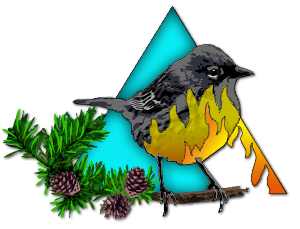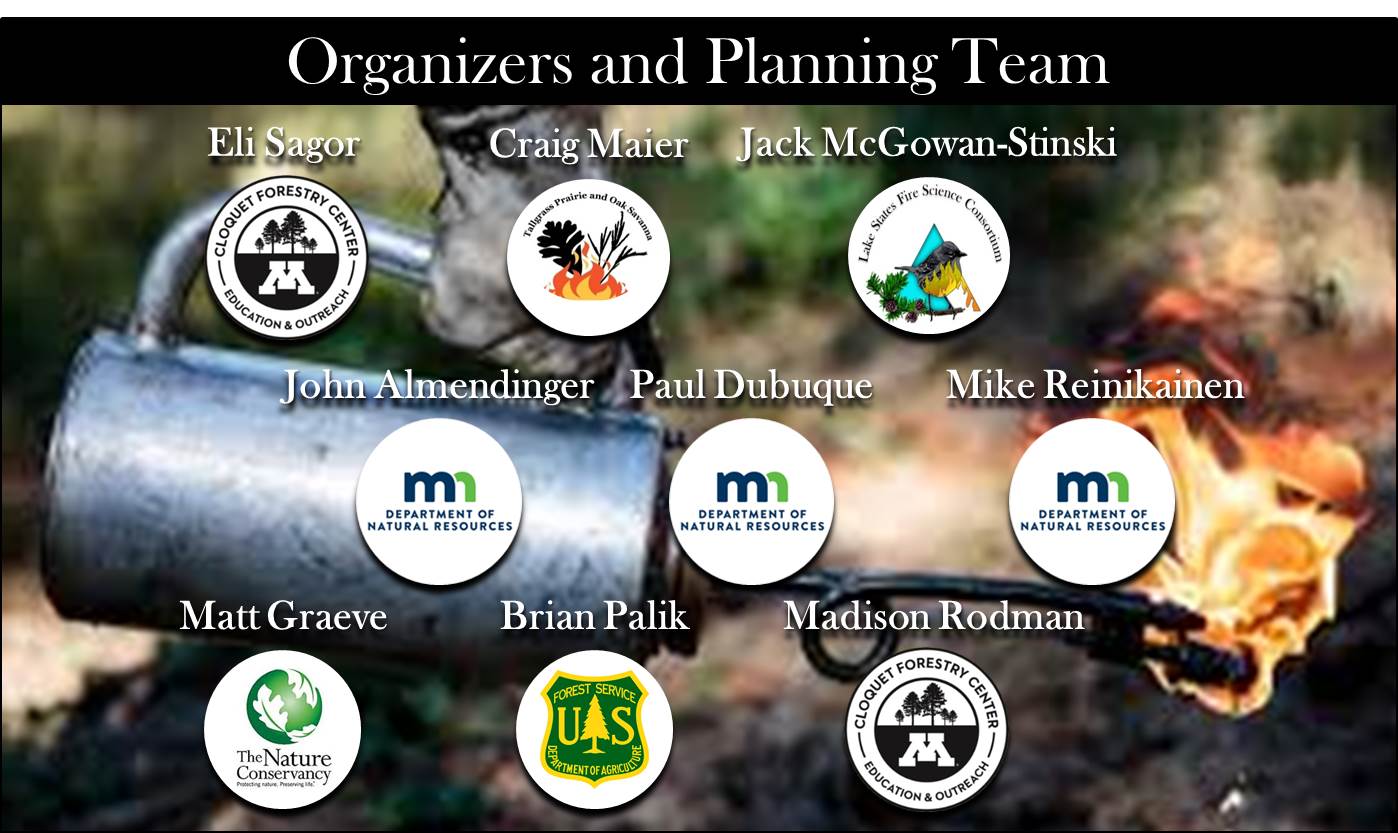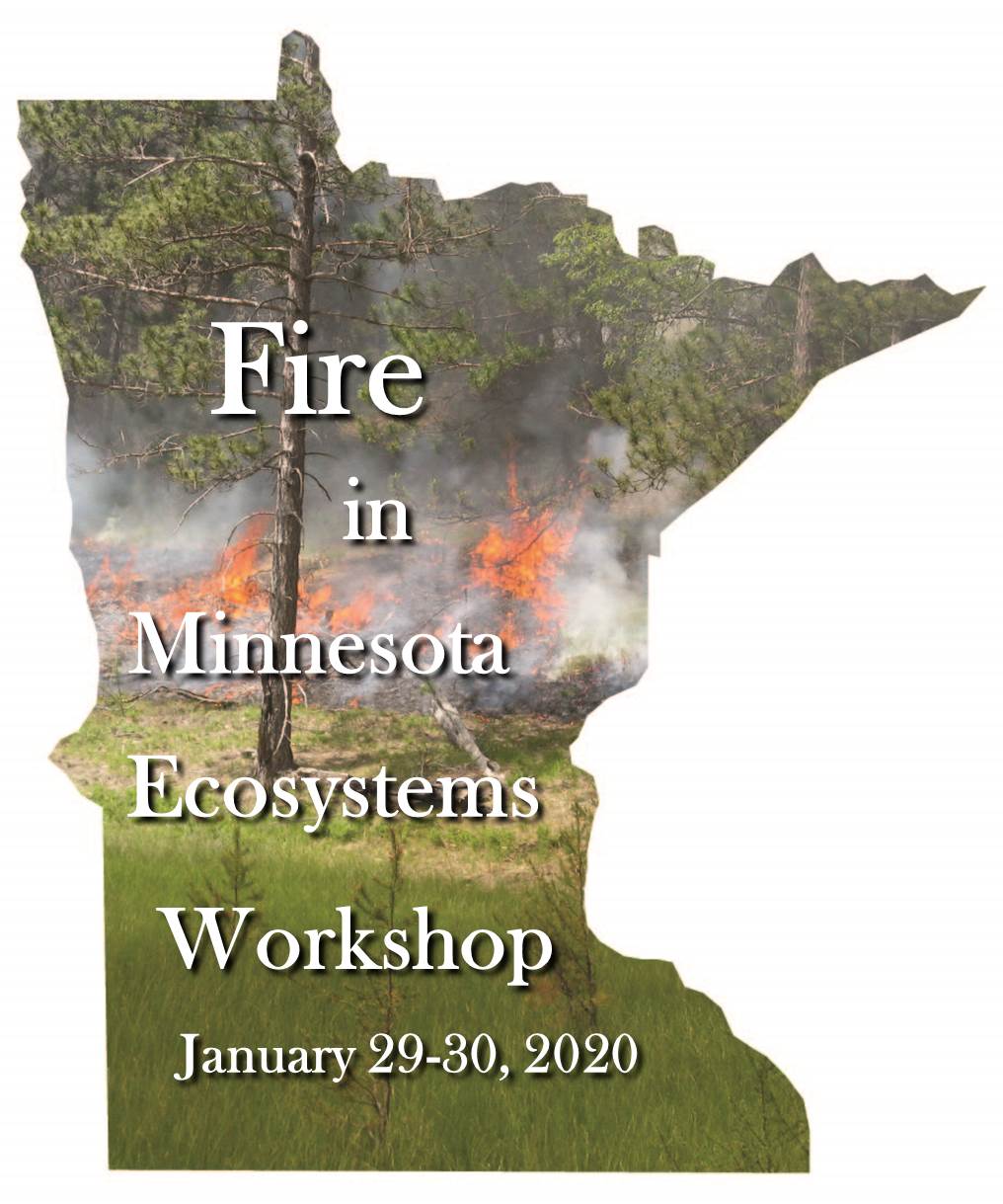Navigation

Upcoming Events
There are no events planned.
Workshop
Fire in Minnesota Ecosystems Workshop
January 29-30, 2020
Slides presented at the event
Recordings of presentations at the event
Fire is a major driver of ecosystem dynamics across much of Minnesota. Fire suppression, while beneficial, has changed these systems in ways that may threaten long term ecosystem health and productivity. While a variety of silvicultural and other treatments attempt to mimic some fire effects, there is interest in better understanding the roles and outcomes of fire in order to improve the function of our fire-dependent plant communities in the fire suppression era. This two-day event will explore how fire has shaped Minnesota's natural systems and how land managers can safely reintroduce fire where appropriate. Sessions and panel discussions will focus on the fire history of Minnesota, and fire effects in pine- and oak-dominated forest and woodland communities and the aspen parklands system. These discussions are planned with and for the diverse community interacting around fire-related issues, and seek to build the understanding and communication to support further work toward collaborative solutions.
A collaboration of the Sustainable Forests Education Cooperative and the Lake States Fire Science Consortium. The Tallgrass Prairie and Oak Savanna Fire Science Consortium, the Oak Woodlands and Forest Fire Science Consortium, and the Minnesota Sharp-Tailed Grouse Society are also supporting this Workshop.

Location: University of Minnesota - Cloquet Forestry Center, 175 University Rd, Cloquet, MN 55720
The four topic areas of presenters and panels over the two-day workshop include: Fire History in Minnesota, Oak Ecosystems and Fire, Pine Ecosystems and Fire, Parkland Ecosystems and Fire.
Working Schedule for the Two Days
DAY ONE - Wednesday January 29, 2020 |
||
0830 – 0930 (60 minutes) |
Arrival and check-in |
|
0930 – 0940 (10 minutes) |
Welcome |
Eli Sagor, University of Minnesota Cloquet Forestry Center |
|
|
Jack McGowan-Stinski, Lake States Fire Science Consortium |
0940 – 1030 (50 minutes) |
KEYNOTE: Applying the US Forest Service’s National Ecological Hierarchy to delineate Minnesota’s ecosystems at multiple scales |
Gregory Nowacki, PhD, Regional Ecologist, Acting Soil Program Leader, USDA Forest Service, Eastern Region |
1030 – 1100 (30 minutes) |
KEYNOTE: Fire-dependent Ecosystems of Minnesota |
John Almendinger, Ecological Land Classification Program Consultant, Minnesota Department of Natural Resources |
1100 – 1130 (30 minutes) |
Break |
|
1130 – 1210 (40 minutes) |
Fire History in Minnesota PART ONE |
|
|
Vignettes of North American fire histories |
Michael C. Stambaugh, PhD, Associate Research Professor, Missouri Tree-Ring Lab, University of Missouri |
1210 – 1310 (60 minutes) |
Lunch |
|
1310 – 1340 (30 minutes) |
Fire History in Minnesota PART TWO |
|
|
History as Guide in Approaching a Reciprocal Relationship with Fire and Forests of the Border Lakes Region |
Evan R. Larson, PhD, Associate Professor in the Department of Geography, Director of the Tree-Ring, Earth, and Environmental Sciences Laboratory, University of Wisconsin-Platteville |
1340 – 1400 (20 minutes) |
PANEL for Fire History in Minnesota |
Stambaugh and Larson |
1400 – 1430 (30 minutes) |
Oak Ecosystems and Fire PART ONE |
|
|
Fire as a mediator of competition among oaks, grasslands and mesic forests |
Lee Frelich, PhD, University of Minnesota |
1430 – 1500 (30 minutes) |
Break |
|
1500 – 1600 (60 minutes) |
Oak Ecosystems and Fire PART TWO |
|
|
Managing oak ecosystems with fire in the Eastern U.S. |
Daniel C. Dey, PhD, Research Forester, Project Leader, USDA Forest Service, Northern Research Station |
|
Prescribed fire effects on oak timber value |
Joseph M. Marschall, Sr. Research Specialist, Missouri Tree-Ring Lab, University of Missouri |
1600 – 1630 (30 minutes) |
PANEL for Oak Ecosystems and Fire |
Frelich, Dey, Marschall |
1630 – 1645 (15 minutes) |
Day One Wrap Up |
|
DAY TWO - Thursday January 30, 2020 |
||
0830 – 0840 (10 minutes) |
Welcome Back |
|
0840 – 1010 (90 minutes) |
Pine Ecosystems and Fire |
|
|
Reconstruction of old growth pine and disturbance factors |
Brian Palik, PhD, Research Ecologist and Team Leader, USDA Forest Service, Northern Research Station |
|
Pine woodland and barren restoration: What is possible with late dormant season burns? |
Brian Sturtevant, PhD, USDA Forest Service, Northern Research Station |
|
Managers perspective of reintroduction of fire in pine systems |
Patrick Johnson, Prescribed Fire and Fuels Specialist, USDA Forest Service, East Zone Superior National Forest |
1010 – 1040 (30 minutes) |
Break |
|
1040 – 1110 (30 minutes) |
PANEL for Pine Ecosystems and Fire |
Palik, Sturtevant, and Johnson |
1110 – 1210 (60 minutes) |
Parkland Ecosystems and Fire PART ONE |
|
|
Aspen Parkland - a most dynamic ecosystem of northwest Minnesota |
W. Daniel Svedarsky Ph.D., Emeritus Research Biologist, NW Research and Outreach Center, University of Minnesota |
|
Prescribed burning (and seasonal effects) to improve management for brushland-dependent species |
Rebecca Montgomery, PhD, Department of Forest Resources, University of Minnesota |
1210 – 1310 (60 minutes) |
Lunch |
|
1310 – 1340 (30 minutes) |
Parkland Ecosystems and Fire PART TWO |
|
|
Strategies for Success: Fire in the Aspen Parklands |
Jonathan Eerkes, Land Steward, The Nature Conservancy |
1340 – 1410 (30 minutes) |
PANEL for Parkland Ecosystems and Fire |
Svedarsky, Montgomery, and Eerkes |
1410 – 1440 (30 minutes) |
Break |
|
1440 – 1510 (30 minutes) |
SYNTHESIS: What we heard and where we need to go |
Andrea Brandon, The Nature Conservancy & Patty Johnson, Superior National Forest |
1510 – 1520 (10 minutes) |
Workshop Wrap-Up and Adjourn |
|
For any questions please contact Jack McGowan-Stinski, mcgowan-stinski.1@osu.edu, 989-287-1734 or Eli Sagor, esagor@umn.edu
Organizers and Planning Team (listed alphabetically):
John Almendinger – Minnesota Department of Natural Resources
Paul Dubuque – Minnesota Department of Natural Resources
Matt Graeve – Minnesota Chapter of The Nature Conservancy
Craig Maier –Tallgrass Prairie and Oak Savanna Fire Science Consortium
Jack McGowan-Stinski – Lake States Fire Science Consortium
Brian Palik – Northern Research Station, USDA Forest Service
Mike Reinikainen – Minnesota Department of Natural Resources
Madison Rodman – Cloquet Forestry Center, University of Minnesota
Eli Sagor – Cloquet Forestry Center, University of Minnesota


.png)
